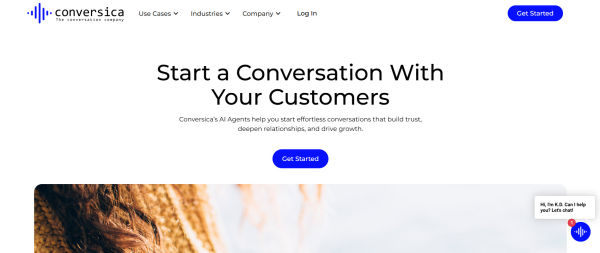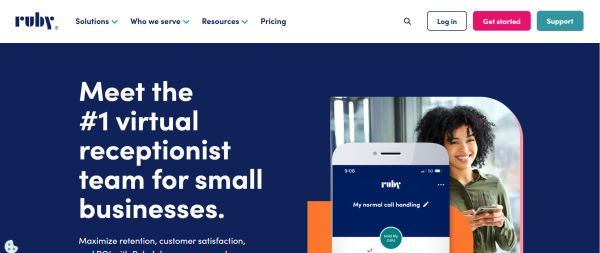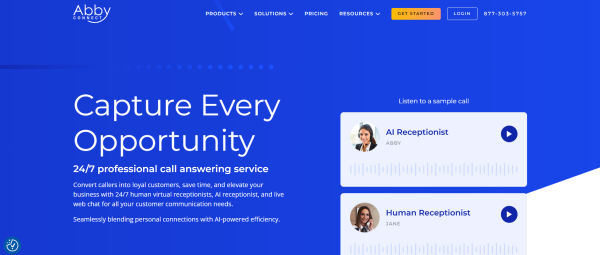When the Front Desk Becomes the Bottleneck
A few years back, I consulted with a mid-sized accounting firm that was losing more clients than they realized. At first, they blamed seasonality. Then pricing. Then, lead quality. But the real issue was buried in their call logs.
Every missed call, especially after hours, either ended up in a voicemail inbox that no one checked or got routed to an overwhelmed admin who couldn’t respond in time. One prospect had called three times in 24 hours and never got a callback. By the time someone followed up, they’d already signed with a competitor.
This isn’t rare. It’s what happens when your inbound call flow depends on human availability. The real cost is missed revenue, damaged first impressions, wasted ad spend, and lost momentum.
That’s why AI answering services have become a must-have for businesses with large incoming call volumes. The right tool does so much more than pick up the phone. It captures context, converts interest, and keeps your business responsive no matter who’s at their desk.
If that’s the kind of system you need, here are seven tools worth your attention.
Top 3 Quick Picks: 2025’s Best AI Answering Services
Rosie AI: Best for Plug-and-Play Lead Capture
- Books meetings directly into calendars
- Natural voice that doesn’t sound like a bot
- Syncs cleanly with CRMs and help desks
Rosie AI is built for teams that need a no-maintenance way to stop missing leads. It’s fast to deploy, easy to train, and smart about caller intent. If you’re dealing with high call volume or short-staffed front desks, this is the one to beat.
Conversica: Best for Sales-Focused Follow-Up
- AI follow-up via email, voice, or SMS
- Auto-qualifies leads based on interaction
- Works across high-volume sales funnels
Conversica doesn’t just answer calls. It works the lead until a rep is needed. For B2B companies, SaaS teams, or anyone trying to increase speed-to-lead, it adds real sales leverage without adding headcount.
Simple Phones: Best for Custom Voice Agents
- Set up in minutes with no dev work
- Train bots with plain language prompts
- Affordable pricing, scalable structure
Simple Phones is ideal for teams who need branded call coverage but don’t want to manage call center software. Create multiple agents, customize responses, and keep everything consistent without overbuilding.
Keep reading for full reviews of all seven services, including picks tailored for regulated industries, high-touch client work, and outbound voice automation.
How to Choose a Service That Doesn’t Just Answer, It Acts
1. Voice Matters More Than You Think
Voice AI has come a long way, but not every provider has closed the realism gap. Callers can detect synthetic tone, even if they can’t always explain why. What sounds “robotic” isn’t just about pronunciation; it’s about pacing, emotion, and response flexibility. If your AI can’t handle interruptions or understand varied phrasing, the caller experience breaks. Choose a tool with proven natural language performance, not just a feature sheet that says “human-sounding.”
2. Calendar and CRM Sync Should Be Native
When someone calls to book time or follow up on an issue, the worst outcome is having the AI promise a callback with no system to make it happen. Tools like Rosie AI and Conversica push call data directly into calendars or CRMs in real-time, turning intent into action. Avoid platforms that rely on email summaries or unstructured notes. If it doesn’t talk to your core systems, it’s just a glorified answering machine.
3. Escalation Logic Separates Smart From Dumb
Call volume isn’t the problem. Call variability is. A good AI receptionist handles basic routing or intake. A great one knows when to step aside. Whether it’s recognizing urgent issues, VIPs, or moments of caller frustration, escalation logic protects the customer experience. Hybrid platforms that combine AI with human backup (like Ruby or Abby Connect) are essential if your calls range from routine to sensitive.
4. Customization Beats One-Size-Fits-All
Your business has a voice, and your answering service should match it. Generic scripts and rigid flows make even the best voice AI feel cold or misaligned. Look for platforms that let you define tone, vocabulary, response logic, and fallback rules. If you run a legal firm, you’ll need a very different call flow than a plumbing service or a software agency. The best tools don’t just offer configuration, they invite it.
5. Real Insight Comes From Post-Call Data
Voicemail is a black hole. The best AI answering services surface trends, categorize conversations, and identify intent patterns. Some (like Levity) even tag call types and trigger internal workflows automatically. Whether you’re managing high volumes or just want to see what’s driving calls, data visibility lets you tighten operations and reduce noise. Transcripts alone aren’t enough; you need structure and insight.
The 7 Best AI Answering Services That Know What to Say (And When)
1. Rosie AI: Best for Plug-and-Play Lead Capture
- Founded: 2024
- Headquarters: Remote
Why Rosie AI is the best AI answering service:Rosie AI delivers automated call handling that sounds like a real person and acts like an ops assistant. It books appointments directly, collects structured intake data, and routes calls based on logic you define. But what makes Rosie AI stand out is how easily it integrates with your tools (Google Workspace, HubSpot, Salesforce, and others) without heavy lifting.
The system supports instant notifications, email or SMS alerts, and full transcripts after each call. It’s ideal for small to midsize teams that can’t afford to miss leads but also can’t justify hiring a full-time receptionist. Onboarding is fast, with no dev work required. For teams that live in their CRM or run fast-paced client intake, Rosie AI brings structure and speed to every inbound call.
2. Conversica: Best for Sales-Focused Follow-Up

- Founded: 2007
- Headquarters: San Mateo, CA
Conversica’s AI assistants engage leads across voice, SMS, and email to qualify them and keep them warm until they’re ready for a rep. It’s purpose-built for sales engagement, especially where response time makes or breaks pipeline movement. Conversica identifies lead intent, schedules meetings, and can follow up automatically if someone goes quiet.
It also connects directly with CRMs like Salesforce and HubSpot, pulling in context and updating records. If your inbound call volume turns into form fills or demo requests, this is a strong solution to prevent drop-off between first touch and follow-up. It’s less about reception, more about conversion.
3. Simple Phones: Best for Custom Voice Agents
- Founded: 2023
- Headquarters: New York, NY
Simple Phones offers a clean, developer-free setup for businesses that want fast control over their voice agents. Users can write plain-language scripts to train bots on FAQs, scheduling logic, or call routing rules. It supports multi-language voice AI, integrates with CRMs and calendars, and can be updated as business needs change.
The pricing is usage-based and straightforward, making it accessible for small shops, side hustles, and early-stage startups. If you’ve ever wanted to build a receptionist without building a call center, Simple Phones offers that bridge.
4. Ruby: Best for White-Glove Answering With a Human Touch

- Founded: 2003
- Headquarters: Portland, OR
Ruby blends U.S.-based live receptionists with light automation to deliver a consistent, brand-aligned caller experience. Businesses define scripts, tone guidelines, and routing preferences. Ruby’s team answers every call live, greets the caller using your instructions, and either routes or records the message depending on the need.
It’s ideal for professional services, law firms, real estate, and consultancies, where tone and polish matter as much as responsiveness. It’s not an AI-first platform, but it brings structure and professionalism to the calls AI might mishandle. Ruby also offers bilingual reception and mobile app access for real-time updates.
5. Levity: Best for No-Code Workflow Automation
- Founded: 2019
- Headquarters: Berlin, Germany
Levity doesn’t answer calls itself; it powers what happens after. Built for teams that already capture calls via voicemail or AI, Levity uses machine learning to classify, tag, and trigger workflows based on what was said. It’s trained on your historical data and requires no coding to implement.
For example, it can detect when a call is about a cancellation, a refund request, or a new lead, then alert the right person, update a CRM, or launch an automated email follow-up. It connects with platforms like Slack, Airtable, Zendesk, and more. If your pain point isn’t answering but acting on calls, Levity makes the system smarter.
6. Air AI: Best for Long-Form Voice Conversations

- Founded: 2023
- Headquarters: Miami, FL
Air AI builds full voice agents that can handle real, nuanced phone conversations up to 10 minutes or longer. The AI speaks naturally, handles complex back-and-forth, and adapts mid-call. It’s strong on intake and booking, especially for industries like legal, healthcare, or high-value service providers, where the first call is often the longest.
It includes CRM sync, call summaries, analytics, and user-defined logic. Air AI is best suited for teams looking to replace entire call flows, not just the first 60 seconds. The pricing reflects its power, but the conversational quality makes it a standout for detail-heavy use cases.
7. Abby Connect: Best for Blended AI and Live Support

- Founded: 2005
- Headquarters: Las Vegas, NV
Abby Connect uses AI to manage routine calls, then escalates to live U.S.-based agents when things get complex. This hybrid model works well for firms with mixed sensitivity where routine booking is fine via automation, but legal intake or upset customers need a real voice.
The platform supports 24/7 coverage, custom scripts, bilingual service, and CRM integration. Pricing is based on usage minutes and includes app access for call review and escalation tracking. It’s a balanced model for teams that want AI efficiency but can’t risk alienating high-value clients with a bad bot experience.
Don’t Just Answer the Phone, Close the Loop
The problem with missed calls isn’t just lost messages. It’s lost trust, momentum, and revenue. AI answering services solve that gap by making sure every call is acknowledged, acted on, and logged in a way that keeps your team moving.
The right service will sound natural, connect seamlessly with your systems, and know when to hand off to a human. More importantly, it will free you from worrying about whether that last ring was a missed opportunity.
Choosing well means you stop treating calls as interruptions and start treating them as assets. With the right AI answering partner in place, the phone goes from being a bottleneck to being one of your strongest growth channels.
Contact to : xlf550402@gmail.com
Copyright © boyuanhulian 2020 - 2023. All Right Reserved.